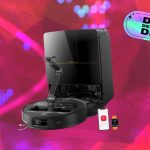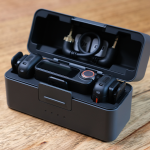
UPDATE: Oct. 13, 2022, 11:30 a.m. EDT This story has been updated to include the best deals on robot vacuums from iRobot, eufy, and more.
We’ve compiled the best deals on robot vacuums from brands like iRobot, Shark, and Ecovacs. Here are the ones to grab as of Oct. 13:
-
BEST BUDGET DEAL: The Shark AI RV2002 is the rare reliable LiDAR-equipped model that’s under $200 — $169
$249(save $80) -
BEST SELF-EMPTYING DEAL: The Roomba j7+ recognizes phone chargers and is back to all-time low pricing at Amazon — $599
$799.99(save $200.99) -
BEST ROBOT VACUUM/MOP DEAL: The Roborock Q7 Max+ is a triple threat of LiDAR, self-emptying, and mopping at a digestible cost — $599.99
$869.99(save $270)
Only three things are certain in life: Death, taxes, and a few days each month when you need to vacuum but just don’t have time. Whether you detest the chore or get a little bummed when you can’t have that satisfying dance with your Dyson, a robot vacuum is a lifesaver. Shop models on sale below.
Robot vacuums under $200

Why we like it
You’d be hard-pressed to find a LiDAR-equipped robot vacuum for less than $200, and even more hard-pressed to find one that can actually find the rooms it maps. On sale for $169, Shark’s model hits the mark, and administers 30% more effective carpet cleaning than its predecessor (according to Shark).
More robot vacuums under $200
-
ionvac Smart Clean 2000 — $99
$179.88(save $80.88) -
eufy RoboVac 30C — $159.99
$299.99(save $140) -
iRobot Roomba 676 — $194.99
$269.99(save $75) -
iRobot Roomba 694 — $199
$274(save $75)
Robot vacuums under $500

Why we like it
The Eufy Robovac X8 features unique Twin Turbine tech, giving you 2000 Pa of suction per turbine. That means you’ll scoop up a ton more dirt, dust, crumbs, and pet hair than a traditional one-turbine robot vac. It also boasts whole-home mapping, no-go zones, and customizable cleaning settings.
More robot vacuums under $500
-
iRobot Roomba i3 Evo — $299
$349.99(save $50.99) -
Neato Robotics D9 — $349.99
$699.99(save $150) -
Shark AI AV2501AE XL — $379.98
$649.99(save $270.01) -
Neato Robotics D10 — $399.99
$599.99(save $200) -
iRobot Roomba j7 — $399
$599.99(save $200.99)
Robot vacuums under $800

Why we like it
Even without the mopping functionality just announced for the Combo version of the j7+, the OG j7+ is still a super solid investment — especially when it drops back to all time low pricing. It was the first Roomba to introduce Genius Technology and PrecisionVision Navigation to avoid small obstacles that were previously problem-causers, like phone chargers and pet waste. The j7+ also self-empties.
More robot vacuums under $800
-
iRobot Roomba i3+ and Braava Jet m6 bundle — $699.99
$899.99(save $200)
Robot vacuum and mop hybrids and dedicated robot mops

Why we like it:
In Summer 2022, Roborock debuted two mid-range self-emptiers (compared to its other self-emptiers, which start at $949.88.) Both uses LiDAR to map your home and head to the rooms you specify, deploying hearty suction and emptying into a compact dock. The Q7 Max+ is the hybrid of the pair, but you’ll have to create a no-go zone to avoid getting carpets wet.
More hybrids and robot mops on sale
-
iHome AutoVac Eclipse Pro — $199
$399(save $200) -
Roborock E5 — $199.99
$359.99(save $160 with on-page coupon) -
Yeedi Vac Max — $249.99
$349.99(save $100 with on-page coupon) -
Eufy RoboVac L35 — $279.99
$399.99(save $120) -
Yeedi Vac Station — $359.98
$499.98(save $140 with on-page coupon) -
iRobot Braava jet m6 — $299.99
$499.99(save $200) -
Dreametech L10 Pro — $369.99
$489.99(save $120) -
Roborock S5 Max — $299.99
$549.99(save $250) -
Eufy RoboVac X8 Hybrid — $319.99
$599.99(save $280) -
iRobot Roomba s9+ and Braava Jet m6 bundle — $999
$1,249(save $250)
Are robot vacuums worth it?
The control of an upright vacuum comes with its own type of satisfaction. But if you’re not one to classify cleaning as cathartic, a robot vacuum could erase that huge, agonizing task from of your chore list. (And did we mention the joy of having « first day clean » floors all the time?)
But whether robot vacuums are worth it or not comes with a caveat: It can’t be just any robot vacuum. A cheap robot vac that doesn’t do the job right — scattering dust, bumping into walls, getting stuck on area rugs — might actually create more work for you.
What to consider when buying a robot vacuum
-
Suction power: A vacuum is the one purchase that you hope sucks a lot. Suction power is typically measured in Pascals (Pa), with most current vacs ranging between 1,500 Pa and 3,000 Pa. Stronger sucking will be needed to pick up heavier pieces of debris (be sure to set a no-go zone around Legos) and to pull matted-down pet hair from rugs.
-
Floor type: Carpeting and high pile rugs will probably require stronger suction than hard floors, as well as special features like an extra-wide or self-cleaning brush roll to prevent hair from wrapping and clogging. Folks in homes with multiple floor types might consider a bigger, sturdier robot vacuum that can hurl itself and its wheels over mats, rugs, and transitions from carpet to hard floors.
-
Automatic emptying: Because robot vacuums are typically under four inches tall, their onboard dust bins are also small — which means they frequently require emptying. (Dustbins fill up particularly quickly in homes with pets.) A self-emptying vacuum takes that job out of your hands, emptying itself into a larger dustbin in its charging dock. These larger bins can typically hold weeks of dirt without needing to be cleaned or dumped out.
-
Home layout: Every robot vacuum is equipped with sensors and drop detection. But if your home has lots of rooms, lots of turns, or lots of close-together furniture, you’ll have fewer navigation issues with an advanced model that uses intelligent mapping to remember exactly how your home is laid out, including labeling of specific rooms, mental notes of staircases, and ability to deploy zone cleaning.
-
Low-profile furniture: No one should have to be scared about what’s accumulated under their couch over the past year. A robot vacuum measuring three inches or less in height should be able to scoot under most low-hanging couches and beds.
-
Battery life and square footage: One of the main complaints people have about their robot vacuum is that it craps out in the middle of the floor. Larger spaces require more time to clean, and it all depends on how annoyed you’ll be if it only finishes a few rooms at a time. Average run times for the list below range between 90 and 200 minutes, which translate to about 500 and 2,800 square feet covered on one charge.
-
App control: WiFi-enabled robot vacuums can be synced with a smartphone app to control scheduling, manual start, cleaning settings, as well as telling your vac to make its rounds when you’re not home. Low-end models that don’t connect to WiFi will usually come with a separate remote. If you’re used to asking Alexa or Google to turn off the lights or tell you the weather, a model with voice integration will blend in nicely.





